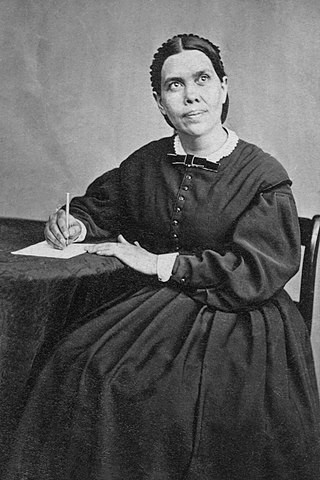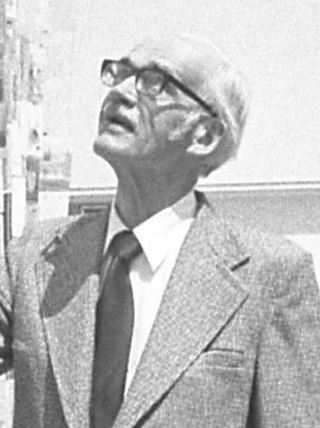
The Seventh-day Adventist Church is an Adventist Protestant Christian denomination which is distinguished by its observance of Saturday, the seventh day of the week in the Christian (Gregorian) and the Hebrew calendar, as the Sabbath, its emphasis on the imminent Second Coming (advent) of Jesus Christ, and its annihilationist soteriology. The denomination grew out of the Millerite movement in the United States during the mid-19th century and it was formally established in 1863. Among its co-founders was Ellen G. White, whose extensive writings are still held in high regard by the church.
Christian radio refers to Christian media radio formats that focus on Christian religious broadcasting or various forms of Christian music. Many such formats and programs include contemporary Christian music, gospel music, sermons, radio dramas, as well as news and talk shows covering popular culture, economic, and political topics from a Christian perspective.,

Ellen Gould White was an American author and co-founder of the Seventh-day Adventist Church. Along with other Adventist leaders such as Joseph Bates and her husband James White, she was instrumental within a small group of early Adventists who formed what became known as the Seventh-day Adventist Church. White is considered a leading figure in American vegetarian history. Smithsonian named her among the "100 Most Significant Americans of All Time".

Amazing Facts is a non-profit Seventh-day Adventist evangelistic ministry based in Granite Bay, California, which broadcasts daily television programming worldwide. It is based on the teachings of Scripture, and especially focuses on the Three Angels' Messages of Revelation 14. Beginning as a radio program dedicated to Christian evangelism, it later expanded into television and online Bible study ministries.

The Voice of Prophecy, founded in 1929 by H.M.S. Richards, Sr., is a Seventh-day Adventist religious radio ministry headquartered in Loveland, Colorado. Initially airing in 1929 on a single radio station in Los Angeles the Voice of Prophecy has since grown to numerous stations throughout the United States and Canada. It was one of the first religious programs in the United States to broadcast nationally. Under the leadership of Shawn and Jean Boonstra, the ministry has now expanded into additional forms of media, including the weekly Authentic broadcast and Discovery Mountain radio adventure series for kids. Additional projects include humanitarian efforts in countries such as India and Myanmar.
It Is Written is an internationally broadcast Seventh-day Adventist Christian television program founded in 1956 by George Vandeman. Its title comes from the Gospel of Matthew: "It is written, 'Man shall not live by bread alone, but by every word that proceeds out of the mouth of God.'" The programs are produced by the Adventist Media Center in California.

Maranatha Volunteers International (Maranatha) is a non-profit Christian organization founded in 1969 and is based in Roseville, California United States with offices in Canada, Latin America, India and Mozambique.

The Seventh-day Adventist Church had its roots in the Millerite movement of the 1830s to the 1840s, during the period of the Second Great Awakening, and was officially founded in 1863. Prominent figures in the early church included Hiram Edson, Ellen G. White, her husband James Springer White, Joseph Bates, and J. N. Andrews. Over the ensuing decades the church expanded from its original base in New England to become an international organization. Significant developments such the reviews initiated by evangelicals Donald Barnhouse and Walter Martin, in the 20th century led to its recognition as a Christian denomination.
The Three Angels Broadcasting Network, or 3ABN, is a Christian media television and radio network which broadcasts Seventh-day Adventist religious and health-oriented programming, based in West Frankfort, Illinois, United States. Although it is not formally tied to any particular church or denomination, much of its programming focuses on Seventh-day Adventist theology and Adventist doctrine.
In Seventh-day Adventist theology, there will be an end time remnant of believers who are faithful to God. The remnant church is a visible, historical, organized body characterized by obedience to the commandments of God and the possession of a unique end-time gospel proclamation. Adventists have traditionally equated this "remnant church" with the Seventh-day Adventist denomination.

The Seventh-day Adventist Church holds a unique system of eschatological beliefs. Adventist eschatology, which is based on a historicist interpretation of prophecy, is characterised principally by the premillennial Second Coming of Christ. Traditionally, the church has taught that the Second Coming will be preceded by a global crisis with the Sabbath as a central issue. At Jesus' return, the righteous will be taken to heaven for one thousand years. After the millennium the unsaved cease to exist as they will be punished by annihilation while the saved will live on a recreated Earth for eternity.
The Seventh-day Adventist baptismal vow is a list of 13 belief statements which a person joining the Seventh-day Adventist Church is given and accepts at believer's baptism. In Adventist understanding, baptism, is associated with officially joining the Adventist church, which is a part of the community of believers in Christ. The vow is explained in the church manual. In 2005 an alternate vow consisting of three statements was approved at the General Conference Session, and the baptizing pastor now has a choice of which set to use. They complement the 28 Fundamentals.
Most Seventh-day Adventists believe church co-founder Ellen G. White (1827–1915) was inspired by God as a prophet, today understood as a manifestation of the New Testament "gift of prophecy," as described in the official beliefs of the church. Her works are officially considered to hold a secondary role to the Bible, but in practice there is wide variation among Adventists as to exactly how much authority should be attributed to her writings. With understanding she claimed was received in visions, White made administrative decisions and gave personal messages of encouragement or rebuke to church members. Seventh-day Adventists believe that only the Bible is sufficient for forming doctrines and beliefs, a position Ellen White supported by statements inclusive of, "the Bible, and the Bible alone, is our rule of faith".

Harold Marshall Sylvester Richards Sr., commonly known as H. M. S. Richards, was a well-known Seventh-day Adventist evangelist and author.

The "three angels' messages" is an interpretation of the messages given by three angels in Revelation 14:6–12. The Seventh-day Adventist church teaches that these messages are given to prepare the world for the second coming of Jesus Christ, and sees them as a central part of its own mission.
George Edward Vandeman was a Seventh-day Adventist evangelist who founded the It Is Written television ministry.
Seventh-day Adventists believe that Ellen G. White, one of the church's co-founders, was a prophetess, understood today as an expression of the New Testament spiritual gift of prophecy.

George Washington Morse was a Seventh-day Adventist pioneer. As a Millerite Adventist, he experienced the Great Advent Awakening including the Great Disappointment of October 22, 1844. He joined the Sabbath-keeping Adventists in the late 1840s and remained a member until he died 60 years later. He witnessed the SDA Church's development for over a half of a century.
The Seventh-day Adventist Church pioneers were members of Seventh-day Adventist Church, part of the group of Millerites, who came together after the Great Disappointment across the United States and formed the Seventh-day Adventist Church. In 1860, the pioneers of the fledgling movement settled on the name, Seventh-day Adventist, representative of the church's distinguishing beliefs. Three years later, on May 21, 1863, the General Conference of Seventh-day Adventists was formed and the movement became an official organization.
The Pillars of Adventism are landmark doctrines for Seventh-day Adventists. They are Bible doctrines that define who they are as a people of faith; doctrines that are "non-negotiables" in Adventist theology. The Seventh-day Adventist church teaches that these Pillars are needed to prepare the world for the second coming of Jesus Christ, and sees them as a central part of its own mission. Adventists teach that the Seventh-day Adventist Church doctrines were both a continuation of the reformation started in the 16th century and a movement of the end time rising from the Millerites, bringing God's final messages and warnings to the world.










